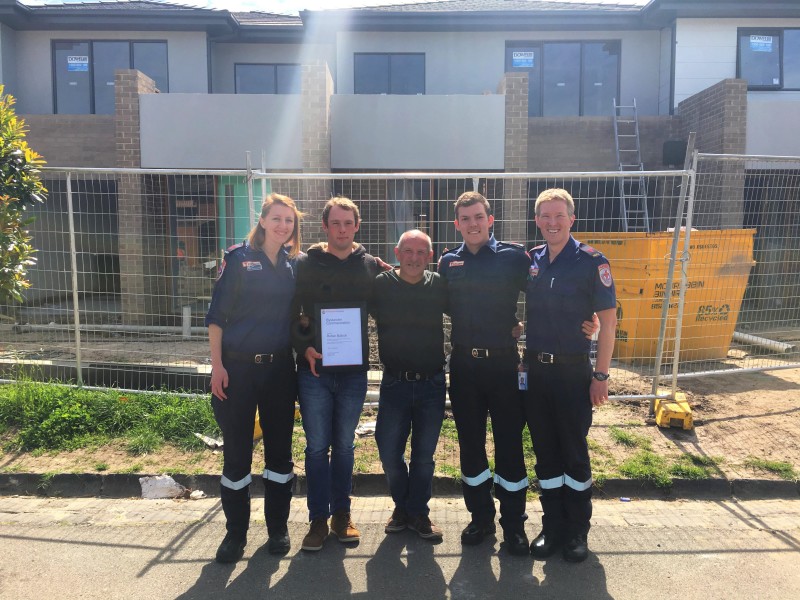Sky high CPR saves a life, puts us on cloud 9
November 4, 2016in AED, Community News
Realising that someone is in cardiac arrest is daunting at the best of times, but when Rohan witnessed his boss Michael collapse on top of a roof, it took the medical emergency to a whole new level.
The two tradies had almost completed a week-long tiling job in Mordialloc on 3 August and were working alone on top of a block of units. It was unusual for that time of morning – at 8.30am on most days, Rohan, 24, would be on the ground mixing mud while Michael, 60, would be chipping away at the work upstairs, somewhere out of sight.
Rohan recalls standing just metres away from Michael when the unthinkable happened. He watched his boss of four years make his way along a ridge between two adjoining roofs before suddenly collapsing.
‘I thought he might have broken a tile and just fallen over, but I could tell pretty quickly that it was something more serious,’ Rohan said.
‘I just kept saying ‘Mick, are you alright!? I phoned for an ambulance (by calling Triple Zero) and told them he wasn’t breathing.’
Unable to attract attention of anyone nearby, Rohan relied heavily on instructions from the ESTA call-taker and performed CPR for the first time.
‘At that stage I couldn’t really feel anything. You just do what you’re told and try to do what’s best,’ Rohan said.
‘There was a moment where I started to feel myself panic but I just thought “no, calm down, just do what you’re instructed and it will all be OK”.’
Minutes later, Rohan felt relief when he saw Mordialloc paramedic Sam Peart appear on the roof wearing a hardhat and clutching an Automated External Defibrillator (AED).
Sam’s paramedic partner Jade Lo Rosso wasn’t far behind, alongside MFB firefighters who were also called to the case through our Emergency Medical Response (EMR) partnership.
Over the following minutes, Jade and MFB firefighters relieved Rohan of compressions while Sam administered two shocks using the AED.
Thankfully, it was at that moment that paramedics identified Michael had return of spontaneous circulation (ROSC).
Mobile Intensive Care Ambulance (MICA) paramedics Simon Pearce and Simon Law had also arrived on scene. For Simon Law, it was his first case as a MICA student and both helped treat and stabilise Michael
‘It was a pretty amazing feeling. It was such a team effort,’ Sam said.
‘But then we were faced with another pressing challenge and that was getting him off the roof – that was an another kettle of fish.’
The MFB called in their High Angle Rescue Team (HART) and were able to harness Sam into a cherry picker to allow him to continue to treat the patient as they were safely transported to the ground. Michael was then put into an ambulance and taken to Monash Hospital.
‘When we got him to hospital something that really stood out to me was one of the doctors said that from the magnitude of the cardiac arrest, they wouldn’t have expected him to make it to hospital alive,’ Sam said.
‘It was such an amazing outcome. We were on a high for such a long time afterwards.’
Michael, who is now in good health, has been looking forward to being reunited with Rohan, paramedics, firefighters and doctors who helped save his life.
‘I haven’t been able to remember a thing about what happened…that whole week is a blur,’ Michael said.
‘I am so grateful to everyone. My whole family has thanked Rohan. My sister met him a few weeks later and she called him ‘the lifesaver’.
‘Nothing phases him, he just goes about what he needs to do. He has a very cool head under pressure…I wouldn’t have wanted to be around anyone else up there.’
Jade said the case was a perfect example of the ‘chain of survival’ – a process which can help save the lives of people in sudden cardiac arrest.
‘It just goes to show that CPR saves lives,’ Jade said.
‘The six steps in the ‘chain of survival’ are, early recognition of cardiac arrest, early access to emergency care (calling Triple Zero), early CPR, early defibrillation, early advanced care (paramedics) and definitive care (hospital).
‘If Michael’s workmate hadn’t identified that he was going into cardiac arrest, called Triple Zero (000) and started performing CPR, he wouldn’t be here today.’

(L-R) Paramedic Jade, bystander Rohan, patient Michael, and paramedics Sam and Simon were reunited at the scene of the incident.
